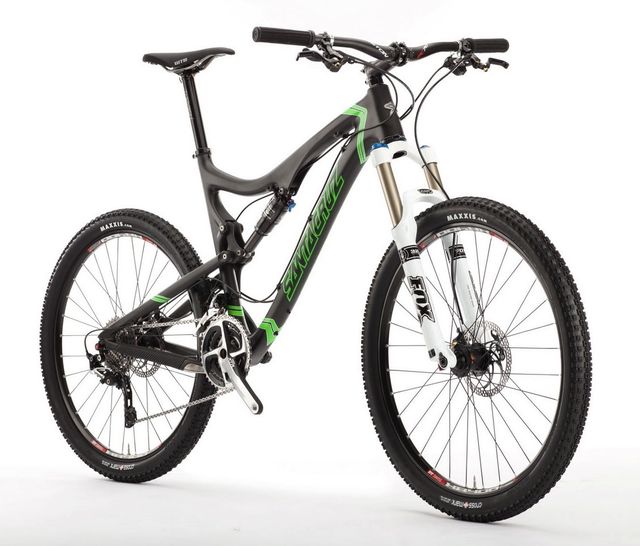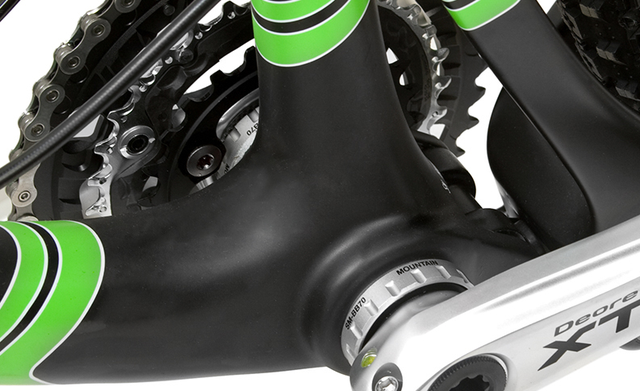
At first glance, the Santa Cruz TRc (as in Trail Carbon) seems to fit neatly between the California company's venerable Blur XC model, a nimble, fast race platform with four inches of travel, and its more enduro oriented 5.5-inch Blur LT. Indeed, looking at the TRc stats on paper (five inches front and rear), we almost wondered whether the bike wasn't an unnecesssary squeeze job—why not go with one of the exisiting Blurs? But from the very first ride, it became clear that this bike is more than just the sum of its numbers. For a five-inch 26er, the TRc is surprisingly slack and low-slung, which makes it agile and grounded and totally playful on all downhill terrain, yet it's nearly as light as a cross-country rig. That makes for one of the must fun yet idiosyncratic rides around (several testers called the geometry “odd”), a bike that can do almost anything in the right hands but isn't the one most people will want to ride all day, every day.
THE FRAME
If you appreciate quality and beautiful finish work, you'll love the TRc frame, with gorgeously sculpted carbon that's especially voluptuous in the hewn linkages and the stout bottom bracket area. This sort of attention to detail presages lasting quality, and indeed in six months of riding the frame proved notably durable without any nicks or dings in spite of the rocky-choked trails we frequented.

To understand the ride, it's helpful to consider the numbers: 125mm rear end mated to a 130mm fork; 68 degree head tube (which is 1.5 degrees less than the XC and marginally slacker than the LT); 13.1-inch high bottom bracket (almost a full inch lower than the LT); and yet a longer wheelbase than either of its Blur counterparts. That extra length combined with the low bottom bracket is what gives the TRc such a rooted, stable feel when descending, and almost every tester commented on how it felt like you could carve turns on this bike.
The downside of the low design, however, is that clearance was pretty tough, and we often found ourselves slamming pedals when trying to clear rocks and waterbars on climbs. Similarly, while the slacked-out front end made steep, techy descents feel easy, the front end felt wandering and light when climbing. At 24.5 pounds, the bike goes uphill just fine and fast—credit, in part, the steep seat tube angle (72.5 degrees), which makes for efficient pedaling—but it did take us a bit of time to figure out that you really have to shift forward in the saddle to keep both wheels gripping the climbs.
Santa Cruz uses the VPP suspension for all its top-shelf bikes, and the tried-and-true design doesn't disappoint here, with solid traction for low-speed climbing and, more importantly, an incredibly plush, linear feel on descents. This bike is most in its element when pointed downwards, and it ate up ledges, steps, and medium-size rock drops. Because the TRc has only five inches of travel, however, you'll have to pick your lines a bit more carefully and probably not go hucking off anything too big or burly.

THE PARTS
We tested the SPX build, which, with Shimano XT components and Fox Kashima-coated RP23 shock and Float 32mm fork, is a great value for the $5,200 sticker price. There are both cheaper and more expensive build options, but if you can swing it, this kit is the way to go. The only thing we missed was the RockShox Reverb dropper post, though that's an easy after-market add (and one we'd definitely recommend).
The bits and pieces on the bike were mostly just as high-quality as the drivetrain and suspension, with bomber Thompson stem and seatpost, carbon bars from Easton, a WTB Silverado saddle (our favorite), and DT 350 hubs (like!) laced to XR400 rims. The hoops were the only place on the bike we had trouble. Though they were plenty stiff, we managed to bang them up easily, and the two or three dings and dents we put in them (none of which led to flats) made us wonder about the long-term durability of these rims. Also, the Maxxis Crossmark tires that come spec are far too skinny (2.1) and flimsy (we tore sidewalls both front and rear) for a bike that's so good at ripping descents. Still, compared with the otherwise high-value components, those are negligible complaints.
THE BOTTOM LINE
Out of the box, the TRc is beautiful. We don't generally go in for the resurgence of '80s Day-Glo green, but Santa Cruz has used the color so effectively that every tester liked the looks. There was a solid consensus on the ride, too, with most riders returning from test laps with big smiles on their faces. The XC racers in the group groused a bit about the climbing and pedaling limitations of the geometry, but everyone loved the way you could flick it down loose, chunky climbs.
That in mind, unlike most bikes in this category, which are hopped-up XC machines aimed at giving the fast crowd a little more squish, the TRc is probably better suited for downhillers looking for something pedalable but no less fun than their big rigs. It's the equivalent of a short trick ski: playful, tons of fun to ride, but also a niche machine that's not necessarily the bike for everyone nor for every trail. For the right situation, though, there's no more entertaining ride out there.
—Aaron Gulley